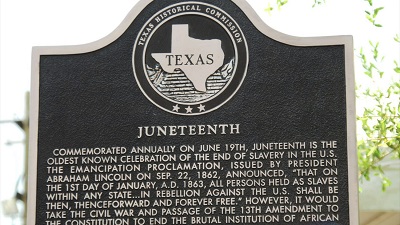Juneteenth and the Ongoing Fight for Equality
 Each Juneteenth, Texans celebrate the anniversary of the end of slavery in our state, and our nation’s continued progress towards equality. This year, our nation is grappling with how far we still have to go.
Each Juneteenth, Texans celebrate the anniversary of the end of slavery in our state, and our nation’s continued progress towards equality. This year, our nation is grappling with how far we still have to go.
As a history buff, I stand by the old adage: Those who don’t learn from history are doomed to repeat it.
Studying where we’ve been helps me better understand where we should go. And sometimes - like now - it shines a light on long-term challenges we’ve not yet overcome.
As our nation looks at modern racial injustice, we’re confronted with our deeply flawed past. America was founded on ideals of freedom, opportunity, and equality – ideals that we know our slaveholding Founding Fathers practiced selectively in their own lives.
As I seek solutions, I’m also celebrating a step we’ve taken this year toward memorializing African-American history. A few months ago, a bill I co-authored with Congresswoman Sheila Jackson Lee from Houston to begin the process of establishing an Emancipation National Historic Trail was signed into law.
The Emancipation Trail follows the path hundreds of freed slaves took from Galveston to Houston to spread the great news U.S. Major General Gordon Granger announced on June 19, 1865: that all slaves were freed. General Order No. 3 made it clear: “This involves an absolute equality of personal rights and rights of property between former masters and slaves.”
Our bill, now law, outlines a 51-mile route from Galveston to Houston, stopping at some of the most significant historic sites along the way.
The beginning of the trail in Galveston will be marked by the site of the former Osterman Building, local headquarters of the Union Army during the Civil War and where General Granger famously read General Order No. 3. The building itself has been demolished, but you can find a historical marker in its place.
There’s also the Reedy Chapel in Galveston, Texas’ first African Methodist Episcopal Church and one of many century-old African-American churches on the island. Reedy Chapel was established in 1848 when then-slaves began gathering outdoors for services, and more than 172 years later the congregation still gathers for an annual Juneteenth celebration and for services each Sunday. My wife and I had the privilege of visiting Reedy Chapel earlier this year to meet its pastor and some of its members.
In Houston, the Emancipation Trail stops near Freedmen’s Town, an urban colony established in the 1860s for freed slaves and known for its iconic brick roads, hand laid by the new residents. Today, the historic Freedmen’s Town lies within Houston’s Fourth Ward and is home to the African American Library at the Gregory School and the Rutherford B.H. Yates Museum dedicated to the neighborhood’s history.
Emancipation Park in Houston is a final stop on the trail, bought and named by a group of African-Americans in 1872 for a spot to commemorate Juneteenth. Led by Reverend Jack Yates, a Baptist minister and former slave, the group pooled their $1,000 to purchase 10 acres of open land for the celebration. Nearly 150 years later, the beautifully renovated Emancipation Park still serves the people of Houston – now with a pool, baseball fields, and tennis courts.
I visited Emancipation Park earlier this year with Rep. Jackson Lee, Houston Mayor Sylvester Turner, and other community leaders for a walking tour and to discuss the importance of establishing the Emancipation Trail – which would become only the second National Trail commemorating African-American history.
155 years later, we’re still on the road toward the “absolute equality” ordered by General Order No. 3. But by studying and celebrating the positive steps our nation has taken – through celebrating Juneteenth, or establishing the National Emancipation Trail – we can better understand how to move forward.



